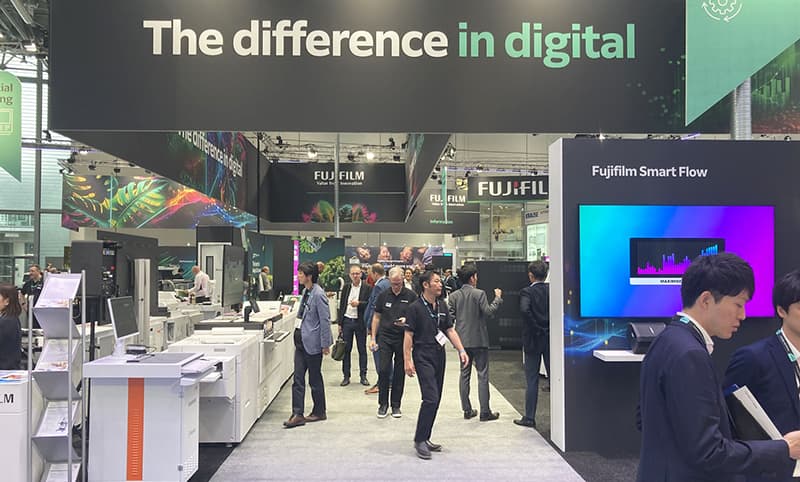In conversation with Manuel Schrutt, Director Business Strategy Packaging – Global, FUJIFILM Corporation.
How has drupa been so far?
Customers have received us very positively, especially with our innovative product designs. We’re quite optimistic about our new product lineup.
Let’s delve into AQUAFUZE, the inkjet ink technology. Fujifilm says it revolutionizes indoor applications. Why?
AQUAFUZE represents a breakthrough that the industry has long sought, combining the benefits of water-based and UV-curable ink technologies. While no one has succeeded before, we have. This technology opens up new possibilities for wide-format inkjet printing applications, particularly for indoor signage and wallpaper. Currently AQUAFUZE is primarily used for wide-format applications. We may explore other uses in the future, but for now, it’s tailored for multipass wide-format production.
What about the Revoria Press GC12500? Is that used for packaging applications?
The Revoria Press GC12500 can be used for packaging, but it primarily serves the commercial print space. Our portfolio includes both toner and inkjet solutions with the Revoria and Jet Press lines, respectively. The Revoria Press GC12500, a duplex B2 machine, complements our lineup, which also features the high-speed Jet Press 750S B2 sheet-fed inkjet digital press. The Jet Press 750S is ideal for short-run, versioned packaging material due to its water-based inkjet printing quality.
You also have the DE1024 Digital Embellishment Printbar. Can you explain more about this technology?
Our digital embellishment system leverages Fujifilm’s inkjet technology to add embellishment effects on existing machines. The FUJIFILM DE1024 can seamlessly integrate into label presses and other machines to apply varnish without requiring an additional press.
Does this system only work with Fujifilm machines?
No, it integrates with various machines. The inkjet unit, supplied by Fujifilm, can be incorporated into existing processes to replace traditional embellishment methods like screen printing.
But does it support different print widths?
Yes, the FUJIFILM DE1024 is available in various print widths and configurations to accommodate different varnish thicknesses.
And if so, what is the maximum width?
Currently, the standard portfolio goes up to one meter. It’s designed to fit flexo label presses, screen presses for embellishments, or offline coating machines.
So it can be used with third-party equipment?
Absolutely. The whole idea is to integrate it wherever embellishment is currently done in an analog way, transforming it into a digital process using the same machines.
Let’s talk about the Jet Press FP790. Is this for flexible packaging?
Yes, the Jet Press FP790 is our new machine designed specifically for flexible packaging, but we start to see demand for other applications like IML labels as well.
Is this the first digital press for flexible packaging or are there others?
It’s one of the first real industrial presses for flexible packaging. While other players have toner technologies for flexible packaging, we are among the pioneers in water-based inkjet on an industrial scale.
What is the maximum speed?
The Jet Press FP790 prints at high speeds of 50 meters per minute on substrates up to 790 mm wide. While flexo machines can reach around 400 meters per minute, our focus is on efficiently handling short and medium print runs that would otherwise require extensive setup on traditional machines.
How do you manage tension control in the digital machine?
The press is designed to be plug-and-play. The process remains the same like with analogue presses except for the method of inking. We use the same substrates and finishing processes, ensuring compatibility with existing equipment.
What is the minimum and maximum thickness you can work with?
We can print on substrates as thin as 7 microns and as thick as 100 microns. This applies to flexible packaging materials, including film and paper, allowing for applications like gift wrapping paper.
Our magazine, ME Printer, is published in both English and Arabic, targeting readers in the Middle East. How important is the Middle East market for Fujifilm, and how is the market evolving for you?
The Middle East is a significant market for us, particularly in packaging. We have a strong presence through our Dubai-based operations. The region is experiencing a boom in packaging production, making it a key area for growth. We’ve started selling digital equipment there and have seen strong demand for our FP790 and analogue packaging portfolio.
At drupa, did you close any sales deals?
Yes, we were very successful, particularly with the FP790, which was the star of the show for us. drupa served as the starting point for its global rollout.
There’s a lot of talk about sustainability. What is Fujifilm’s approach and strategy towards sustainability?
We aim to be CO2 neutral by 2030. This includes our products. For instance, our flexo plates use water wash technology, eliminating the need for chemicals and reducing waste. We also recycle and reuse water, which is crucial in regions like the Middle East. Our partnerships with companies like Henkel ensure that our solutions are plug-and-play, minimizing the need for special adaptations.
How do you see the impact of the significant presence of Chinese manufacturers at drupa?
Competition, including from Chinese manufacturers, is a good thing. It drives us and other major companies to innovate and improve. While some customers may be unfamiliar with Chinese companies, leading to hesitations, competition is ultimately beneficial for the industry. It pushes everyone to be better and more innovative.
